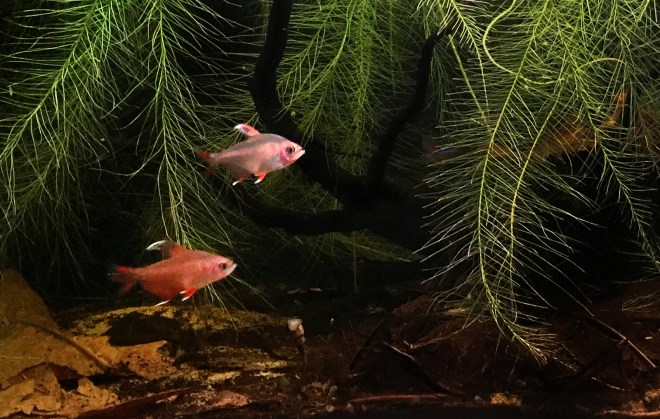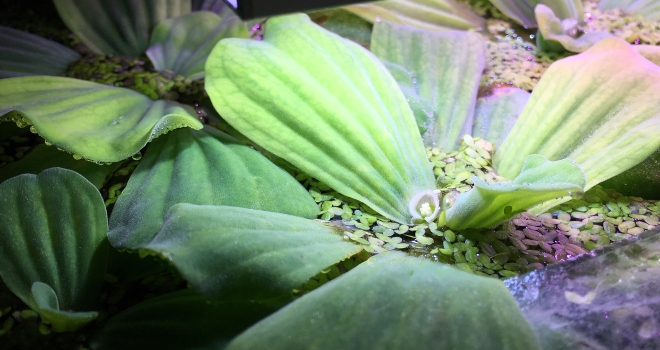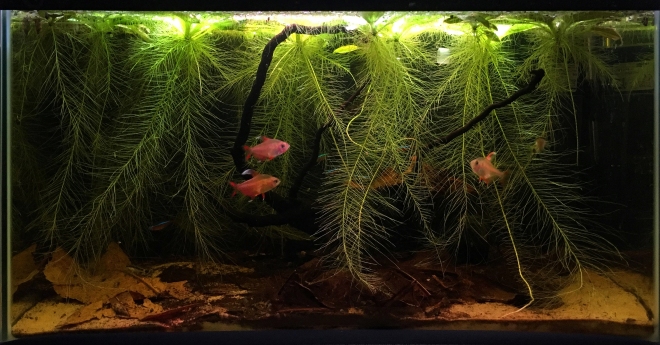Biotope
There is something quite rewarding about setting up a biotope tank. With high lighting, dosing and CO2 readily available to more everyday hobbyists, it is tempting to go the purely artistic route and select plants, fish and decor for our tanks that look nice and have aesthetic appeal together.
But sometimes, it’s nice to limit choice and select flora and fauna originating from a specific environment. A biotope aquarium can be like having a slice of natural habitat in your home, and more often than not the fish display natural behaviours and colours rarely seen in more “ornamental” tanks.
I think the Amazon blackwater biotope is the easiest to set up and maintain, especially as it’s not dependent on submerged plant growth which many beginner hobbyists struggle with. The Amazon blackwater biotope is characterised by slow flowing dark, tannin-stained water, little to no submerged plant growth a substrate covered with leaf litter at varying stages of decomposition. Fish species are varied, including many species of tetras, corydoras and otocinclus.
Hardscape and Fauna
Keeping the layout simple, I used a shallow layer of sand covered with catappa leaves and a piece of driftwood. I decided on a shoal of cardinal tetras for this tank, an obvious choice for an Amazon biotope. They acclimated extremely well and coloured up fully within an hour of introduction to the tank. The Otocinclus I added were also quick to acclimate to the tank, and within hours they were swimming around and feeding among the leaf litter.


It took me a while to decide which “showcase fish” to add to the tank, as many Amazon biotope aquariums I’ve seen either contained a huge shoal of tetras, Discus or Angelfish. None of these would be suitable for the size of my tank, so I decided to add a small group of Bentosi’s Tetra, a deep bodied species of Tetra with very interesting white-tipped finnage. Like the other fish, the Bentosi’s acclimated much faster than I’m used to and the following morning they were showing breeding behaviours among the roots of floating plants.

I also added various snails and cherry shrimp, although not specifically from the amazon, their versatility and readiness to breed make them extremely useful in any tank.
Water Conditions
I’m using standard dechlorinated tap water in this tank with a pH of 7.4, although decaying leaf litter tends to reduce pH to 6.5. The leaf litter is also responsible for staining the water a brown colour, mimicking the natural habitat. Cardinal tetras require a temperature of ~26-28ºC, which is higher than most other tropical fish which do well at 24ºC. I used an acetate lid to reduce heat and evaporative loss, without which I’d lose almost 2 litres a week. The lid also has the effect of increasing the heat and humidity of the air surrounding the floating plants, which may be beneficial to plant growth. I’m dosing APF’s Trace/Macro EI solution, although only 1/4 of the recommended dose and adjusting according to the condition of duckweed (or “duckweed index”). I think that any old aquarium fertiliser providing trace elements and potassium would work here, as nitrates and phosphates are quite high in London tap water anyway.
Plants
I decided to use the floating plants water lettuce (Pistia), duckweed (Lemma), Salvinia and Amazon Frogbit in this tank, as they are commonly found among the banks of the Amazon river. In the aquarium, they serve a useful function of biological filtration, drastically reducing the need for a bacterial based biological filter to remove ammonium. This is advantageous as nitrifying bacterial filters take time to develop, lower pH as they work and produce nitrates which accumulate over time (nitrate creep). Plants absorb ammonium from fish waste directly, and use it to produce their own biomass. In this way, the hobbyist can “remove” nitrogen from the aquarium simply by pruning plants. The roots of water lettuce and duckweed also provide a huge surface area and substrates for bacterial colonisation, and it is likely that nitrifying bacteria are also present here, although I suspect much of the ammonium uptake is by the plants themselves.
I find that my heavily planted tanks don’t suffer from nitrate “creep” at all, unlike my lightly planted goldfish tank which relies on a bacterial filter for nitrification and requires weekly water changes to keep nitrates in check.
I found that the Pistia got quite large (30cm across) despite being indoors, which I can attribute to either the high humidity under the acrylic sheet or the high lighting from the LEDs (more on this below). After a certain size, Pistia starts producing small white flowers about 10mm long from the centre of the rosette. In my other tanks exposed to “room air” and with lighting suspended higher over the tank, the water lettuce would only grow to about 7cm across and produce no visible flowers at all.

Lighting
Relying to plants for biological filtration requires rampant healthy growth. A straggly piece of elodea probably won’t do much to reduce ammonium levels. To encourage fast plant growth, I’m using two TMC Aquaray 400 tiles at 12W each mounted about 20cm above the tank, which should provide considerable PAR at the surface and mimic the tropical sun. Normally for a tank this small I would not run these lights over 40% unless I knew I could keep CO2 levels stable enough to prevent algae growth, but the dense shade provided by the floating plants as well as the tannin stained water prevent excessive light from reaching the substrate or front glass, and I never have problems with algae.
One of the factors that makes a blackwater biotope tank so easy is that algae growth is low. You can throw tons of light onto the tank to encourage fast growing floating plants to out-compete algae, and the tannin stained water prevents excessive light from reaching submerged surfaces.
Circulation
Whichever method of circulation I used in this tank, I wanted it to be very gentle to represent the slow moving blackwater habitats. Slow water movement also allows the leaf litter to settle nicely and not get bunched up in a corner of the tank. Originally, I decided to use an airstone in the corner to provide some water movement, however this produced tiny droplets which covered the leaves of Pistia with tannins and biofilm. The airstone was also very loud which was a no-no for my bedroom.
The tank is now circulated by a fairly cheap 100l/h internal filter, with a spraybar attachment to distribute the flow more evenly. A simple coarse sponge is used in the media compartment, simply to prevent snails and debris entering the impeller shaft.

I suppose the main reason for this post was to demonstrate how easy it is to set up and maintain a biotope aquarium like this. With the availability of CO2, nutrient dosing and ever more complicated filtration and equipment, it is easy to get caught in the high-tech trap. This biotope is the opposite, with only the most basic of equipment, low running costs and minimal maintenance. Oh and lots of leaf litter and happy fish.

what size is the tank?
It’s a 40L tank